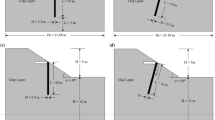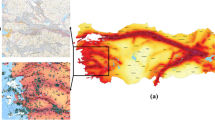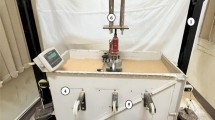Abstract
The magnitude of lateral earth pressure plays an important role in the analysis and design of earth retaining structures. Expanded polystyrene (EPS) geofoam panels have been successfully used in reducing lateral thrust on walls under static loading condition. The presence of geofoam panels between a rigid wall and the backfill soil allows for controlled deformation to develop, which leads to the mobilization of soil shear strength. When subjected to dynamic loading, the magnitude of earth pressure acting on a rigid wall can become significantly larger. In this study, a finite element model is developed to investigate the effectiveness of installing geofoam buffer behind a rigid retaining wall on the seismic lateral thrust induced by the backfill material. A parametric study was then conducted to investigate the effect of geofoam density, relative thickness of the geofoam with respect to the wall height and the friction angle of the backfill soil on the effectiveness of this technique to reduce the impact of seismic events on the stability of the wall. Results showed that provision of geofoam behind rigid non-yielding retaining wall can provide 10–40% reduction in seismic thrust depending on the geofoam density, relative thickness and frictional properties of the backfill soil.











Similar content being viewed by others
Data Availability
The data that support the findings of this study are available on request from the corresponding author.
References
Horvath JS (1992) New developments in geosynthetics; ‘lite’ products come of age. Standardization News 20(9):50–53
Horvath JS (1995) Geofoam geosynthetic,. Horvath engineering, New York, p 217
Horvath JS (1991) The case of an additional function. IGS News 7(3):17–18
Aaboe R (2000) Evidence of EPS long term performance and durability as a lightweight fill. Vegteknisk avdeling
Frydenlund T (1991) Expanded polystyrene: a lighter way across soft ground, vol 1502. ICON Group International
Elragi AF (2000) Selected engineering properties and applications of EPS geofoam. ProQuest Dissertations and Theses
Jutkofsky W, Sung J, Negussey D (2000) Stabilization of embankment slope with geofoam. Transport Res Rec JTransport Res Board 1736:94–102
Sheeley M (2000) Slope stabilization utilizing geofoam. Master's thesis, Syracuse University, New York
Srirajan S (2001) Recycled content and creep performance of EPS geofoam in slope stabilization. Doctoral dissertation. Syracuse University, New York
Negussey D (2002) Slope stabilization with geofoam. Report to FHWA and the EPS industry. Geofoam research center, Syracuse University, New York
Stark TD, Arellano D, Horvath JS, Leshchinsky D (2004) Geofoam applications in the design and construction of highway embankments. NCHRP Web Doc 65:24–11
Duskov M (1991) Use of expanded polystyrene (EPS) in flexible pavements on poor subgrades. In: Proceedings of the International Conference on geotechnical engineering for coastal development, pp 783–788
Duskov M (1997) Measurements on a flexible pavement structure with an EPS geofoam sub-base. Geotext Geomembr 15(1):5–27. https://doi.org/10.1016/S0266-1144(97)00004-6
Riad HL, Ricci AL, Osborn PW, Horvath JS (2003) Expanded polystyrene (EPS) geofoam for road embankments and other lightweight fills in urban environments. In: Soil and Rock America, 12th Pan-American Conference on soil mechanics and geotechnical engineering and 39th US Rock Mechanics Symposium
Refsdal G (1985) Plastic foam in road embankments: future trends for EPS use. Internal report, Norwegian Road Research Laboratory, Oslo, Norway
Aaboe R (1987) 13 years of experience with expanded polystyrene as a lightweight fill material in road embankments. Nor Road Res Lab Publ 61:21–27
Zou Y, Leo C, Small J (2000) Behaviour of EPS geofoam as flexible pavement subgrade material in model tests. Geosynth Int 7(1):1–22
Negussey D, Stuedlein A, Bartlett S, Farnsworth C (2001) Performance of a geofoam embankment at 100 South, I-15 reconstruction project, Salt Lake City, Utah. In: Proceedings on 3rd International Conference on EPS Geofoam
Farnsworth C, Bartlett SF, Negussey D, Stuedlein A (2008) Rapid construction and settlement behavior of embankment systems on soft foundation soils. J Geotech Geo-Environ Engg 134(3):289–301
Frydenlund T, Aaboe R (1996) Expanded polystyrene-the light solution. In: Proceedings of international symposium on EPS construction method (EPS-Tokyo'96), Tokyo, Japan, pp 31–46
Williams, D.; Snowdon, R. (1990) A 47 Great Yarmouth Western Bypass: Performance during the First Three Years (No. 11); Transport and Road Research Laboratory (TRRL): Berkshire, UK, 1990
Skuggedal H, Aaboe R (1991) Temporary overpass bridge founded on expanded polystyrene. In: Proceedings of the 1st European conference on soil mechanics and foundation engineering, pp 559–561
McDonald P, Brown P (1993) Ultra lightweight polystyrene for bridge approach fill. In: Proceedings of the 11th Southeast Asian geotechnical conference, Singapore, pp 664–668
Bang S (1995) Experimental and analytical study of expanded polystyrene blocks in highway application. In: Proceedings of international seminar on the application of EPS for embankment construction, Korea Institute of Construction Technology (KICT), Seoul, Korea, pp 105–133
Abu-Hejleh N, Zornberg JG, Elias V, Watcharamonthein J (2003) Design assessment of the founders/meadows GRS abutment structure. In: Proceedings of 82nd annual TRB meeting
Meguid M, Ahmed M, Hussein M, Omeman Z (2017) Earth pressure distribution on a rigid box covered with u-shaped geofoam wrap. Int J Geosyn Ground Eng 3(2):11
Meguid M, Hussein M (2017) A numerical procedure for the assessment of contact pressures on buried structures overlain by EPS geofoam inclusion. Int J Geosyn Ground Eng 3(1):2
Meguid M, Hussein M, Ahmed M, Omeman Z, Whalen J (2017) Investigation of soil-geosynthetic-structure interaction associated with induced trench installation. Geotext Geomembr 45(4):320–330
Zarnani S, Bathurst R (2007) Experimental investigation of EPS geofoam seismic buffers using shaking table tests. Geosynth Int 14(3):165–177
Horvath JS (1997) The compressible inclusion function of EPS geofoam. Geotext Geomembr 15(1):77–120
Bathurst RJ, Keshavarz A, Zarnani S, Take WA (2007) A simple displacement model for response analysis of EPS geofoam seismic buffers. Soil Dyn Earthq Eng 27(4):344–353
Ossa A, Romo M (2011) Dynamic characterization of EPS geofoam. Geotext Geomembr 29(1):40–50
Partos A, Kazaniwsky P (1987) Geoboard reduces lateral earth pressures. In: Proceedings of geosynthetics' 87 conference, New Orleans, USA, pp 628–639
Horvath JS (2010) Lateral pressure reduction on earth-retaining structures using geofoams: correcting some misunderstandings. In: Earth retention conference, pp 862–869
Koseki J, Bathurst RJ, Guler E, Kuwano J, Maugeri M (2006) Seismic stability of reinforced soil walls. In: Paper presented at the 8th international conference on geosynthetics, Yokohama, Japan, September 2006, pp 18–22
AASHTO (2010) American Association of State Highway and Transportation Officials LRFD bridge design specifications, 5th edn. AASHTO, Washington, DC
NBCC (2010) National Building Code of Canada. National Research Council of Canada, Ottawa
Inglis D, Macleod G, Naesgaard E, Zergoun M (1996) Basement wall with seismic earth pressures and novel expanded polystyrene foam buffer layer. In: Paper presented at the 10th annual symposium on Earth retention system, Vancouver, Canada
Gaskin AP (2000) Geofoam buffers for rigid walls: An investigation into the use of expanded polystyrene for seismic buffers. Master's Thesis, Queen's University, Kingston, Canada
Hazarika H, Okuzono S, Matsuo Y (2003) Compressible geo-inclusion as a seismic earth pressure reduction technique. In: Paper presented at the 38th Japan National conference on geotechnical engineering
Athanasopoulos GA, Nikolopoulou CP, Xenaki VC, Stathopoulou VD (2007) Reducing the seismic earth pressure on retaining walls by EPS geofoam buffers—numerical parametric study. In: Paper presented at the geosynthetics conference, Washington DC, USA
Bathurst RJ, Zarnani S, Gaskin A (2007) Shaking table testing of geofoam seismic buffers. Soil Dyn Earthq Eng 27(4):324–332. https://doi.org/10.1016/j.soildyn.2006.08.003
Athanasopoulos-Zekkos A, Lamote K, Athanasopoulos G (2011) Seismic isolation of earth retaining walls using EPS compressible inclusions—results from centrifuge testing. In: Paper presented at the 4th international conference on geofoam blocks in construction applications, Lillestrøm, Norway
Dasaka SM, Dave TN, Gade VK, Chauhan VB (2014) Seismic earth pressure reduction on gravity retaining walls using eps geofoam. In: Paper presented at the 8th international conference on physical modelling in geotechnical engineering, Perth, Australia
Ertugrul OL, Trandafir AC (2014) Seismic earth pressures on flexible cantilever retaining walls with deformable inclusions. J Rock Mech Geotech Eng 6(5):417–427. https://doi.org/10.1016/j.jrmge.2014.07.004
Partos A, Kazaniwsky P (1987 ) Geoboard reduces lateral earth pressures. In: Proceedings of geosynthetics, pp 628–639
McGown A, Andrawes KZ, Murray RT (1988) Controlled yielding of the lateral boundaries of soil retaining structures. In: Symposium on geosynthetics for soil improvement at the ASCE convention. vol Geotechnical Special
Karpurapu R, Bathurst R (1992) Numerical investigation of controlled yielding of soil-retaining wall structures. Geotext Geomembr 11(2):115–131
Horvath JS (2004) Geofoam compressible inclusions: the new frontier in earth retaining structures. In: Geotechnical engineering for transportation projects, pp 1925–1934
Lutenegger AJ, Ciufetti M (2009) Full-scale pilot study to reduce lateral stresses in retaining structures using geofoam. Final report, project No RSCH010–983 Vermont DOT, University of Massachusetts, Amherst, MA
Ertugrul OL, Trandafir AC (2011) Reduction of lateral earth forces acting on rigid nonyielding retaining walls by EPS geofoam inclusions. J Mater Civ Eng 23(12):1711–1718
Athanasopoulos-Zekkos A, Lamote K, Athanasopoulos G (2012) Use of EPS geofoam compressible inclusions for reducing the earthquake effects on yielding earth retaining structures. Soil Dyn Earthq Eng 41:59–71
McGown A, Murray R, Andrawes K (1987) Influence of wall yielding on lateral stresses in unreinforced and reinforced fills. Research Report 113, Transportation and Road Research Laboratory, Crowthorne, Berkshire, UK
Khan MI, Meguid MA (2021) Evaluating the role of geofoam properties in reducing lateral loads on retaining walls: a numerical study. Sustainability 13(9):4754
Inglis D, Macleod G, Naesgaard E, Zergoun M (1996) Basement wall with seismic earth pressures and novel expanded polystyrene foam buffer layer. In: Proceedings of the 10th annual symposium of the Vancouver geotechnical society, Vancouver, BC
Sarma SK (1973) Stability Analysis of Embankments and Slopes. Geotechnique 23(3):423–433
Byrne PM, Jitno H, Salgado F (1992) Earthquake induced displacements of soil-structures systems. In: Proceedings of 10th World conference on earthquake engineering, pp 1407–1412
Jitno H, Byrne PM (1994) (1994) A procedure for predicting seismic deformation of earth structures. Vertical and horizontal deformations of foundations and embankments. ASCE, pp 711–725
Byrne PM, Janzen W (1981) Soil stress: a computer program for nonlinear analysis of stresses and deformations in soils. Department of Civil Engineering, University of British Columbia
Cundall P, Board M (1988) A microcomputer program for modelling large-strain plasticity problems. In: Proceedings of the sixth international conference on numerical methods in geomechanics, vol1–3. Innsbruck, Austria, 11–15 April 1988
Hazarika H, Okuzono S, Matsuo Y (2003) Seismic stability enhancement of rigid nonyielding structures. In: Paper presented at the 13th international offshore and polar engineering conference, Honolulu, Hawaii, USA
Dave TN, Dasaka SM (2015) Effect of boundary conditions on earth pressure reduction using eps geofoam. In: Paper presented at the 15th Asian Regional Conference on Soil Mechanics and Geotechnical Engineering, Fukuoka, Japan
Ertugrul OL, Trandafir AC (2012) A physical modeling study on the dynamic response of flexible retaining walls with deformable EPS inclusion. In: Paper presented at the 15th World Conference on Earthquake Engineering, Lisbon, Portugal
Ertugrul OL, Trandafir AC, Ozkan MY (2017) Reduction of dynamic earth loads on flexible cantilever retaining walls by deformable geofoam panels. Soil Dyn Earthq Eng 92(20):462–471. https://doi.org/10.1016/j.soildyn.2016.10.011
Pelekis P, Xenaki V, Athanasopoulos G (2000) Use of EPS geofoam for seismic isolation of earth retaining structures: Results of a FEM study. In: Proceedings of the 2nd European geosynthetics conference, Bologna, Italy, pp 15–18
Armstrong R, Alfaro M (2003) Reduction of seismic-induced pressures on rigid retaining structures using compressible inclusions: a numerical study. In: Proceedings of the 56th Canadian geotechnical conference, Winnipeg, Man, pp 500–505
Zarnani S, Bathurst RJ (2008) Numerical modeling of EPS seismic buffer shaking table tests. Geotext Geomembr 26(5):371–383. https://doi.org/10.1016/j.geotexmem.2008.02.004
Zarnani S, Bathurst RJ (2005) Numerical Investigation of geofoam seismic buffers using FLAC. In: Paper presented at the North American geosynthetics society (NAGS)/GR119 conference, Las Vegas, NV, USA
Zarnani S, Bathurst R (2010) Numerical parametric study of geofoam seismic buffers with different constitutive models. In: Proceedings of the 9th international geosynthetics conference, 2010, pp 1665–1668
Zarnani S, Bathurst RJ (2009) Numerical parametric study of expanded polystyrene (EPS) geofoam seismic buffers. Can Geotech J 46(3):318–338. https://doi.org/10.1139/T08-128
Athanasopoulos G, Nikolopoulou C, Xenaki V, Stathopoulou V (2007) Reducing the seismic earth pressures on retaining walls by EPS geofoam buffers—numerical parametric analyses. In: Proceeding of geosynthetics
Zekkos AA, Lamote K, Athanasopoulos GA (2012) Use of EPS geofoam compressible inclusions for reducing the earthquake effects on yielding earth retaining structures. Soil Dyn Earthq Eng 41:59–71. https://doi.org/10.1016/j.soildyn.2012.05.004
Wang YM, Li H, Zhang H (2012) Numerical simulation for dynamic response of EPS geofoam seismic buffers. Adv Mater Res 378:256–261
Wang D, Bathurst RJ (2012) Numerical analysis of earthquake load mitigation on rigid retaining walls using EPS geofoam. Open Civ Eng J 6:21–25
Iai S (1989) Similitude for shaking table tests on soil-structure-fluid model in 1g gravitational field. Soils Found 29(1):105–118
Bathurst RJ, Hatami K (1998) Seismic response analysis of a geosynthetic-reinforced soil retaining wall. Geosynth Int 5(1–2):127–166. https://doi.org/10.1680/gein.5.0117
Matsuo O, Yokoyama K, Saito Y (1998) Shaking table tests and analyses of geosynthetic-reinforced soil retaining walls. Geosynth Int 5(1–2):97–126
Brinkgreve R, Kumarswamy S, Swolfs W, Waterman D, Chesaru A, Bonnier P (2020) PLAXIS 2D Version 20.03.00.60. Netherlands
Schanz T (1999) Formulation and verification of the Hardening-Soil model. In: RBJ Brinkgreve, beyond 2000 in computational geotechnics, pp 281–290
Acknowledgements
The work presented in this paper is supported by McGill University, Canada and the University of Engineering and Technology, Lahore, Pakistan. Geofoam material data were provided by Plasti-Fab Inc., their contribution is really appreciated.
Funding
Other than the graduate scholarship awarded to MI. Khan, this research received no external funding.
Author information
Authors and Affiliations
Contributions
Analysis, writing original draft, MI. Khan; editing and reviewing, M.A. Meguid. All authors have read and agreed to the published version of the manuscript.
Corresponding author
Ethics declarations
Conflict of interest
The authors declare no conflict of interest.
Additional information
Publisher's Note
Springer Nature remains neutral with regard to jurisdictional claims in published maps and institutional affiliations.
Rights and permissions
About this article
Cite this article
Khan, M.I., Meguid, M.A. A Numerical Study on the Role of EPS Geofoam in Reducing Earth Pressure on Retaining Structures Under Dynamic Loading. Int. J. of Geosynth. and Ground Eng. 7, 57 (2021). https://doi.org/10.1007/s40891-021-00304-8
Received:
Accepted:
Published:
DOI: https://doi.org/10.1007/s40891-021-00304-8




